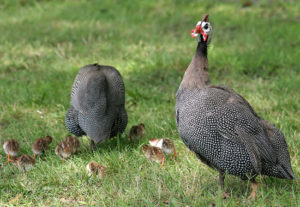
Self-Reliance: Guineas have been companions to human beings since the ancient Greeks, yet they can never be called more than “semi-domesticated.” Guinea fowl will be less dependent on you for care than perhaps any other type of animal you raise. They are able to search out their own food—except in winter—and as a result they are one of the less expensive birds to raise. They are both hot-weather and cold-weather hardy, being adapted from northern Canada to the torrid south, but will need some protection during extremely cold weather. They are less prone to disease than any other poultry, clean in habits, and are not associated with the familiar “poultry” smell.
Insect-Eating: If allowed to roam, guineas will consume more insects than other fowl. Unlike the grain-loving fowl and unlike the plant-eating fowl, guineas are insect eaters. And they will work hard to get bugs. Guineas eat ants and will wipe out ant hills. They eat potato bugs and Japanese beetles. They do not scratch and will not harm garden or flowers; they go there looking only for insects. They chase flies and catch them. They will ride on larger animals, picking insects and catching flies. The guinea is naturally an open-range feeder, but no matter how far it travels in daytime bug searches, it always returns home by evening.
Guinea Patrol: Like geese and watchdogs, guineas make a loud frightened shriek when they notice strangers coming around—human or animal. They have been known to chase away wild birds like robins and waxwings from berry bushes and fruit orchards with their noise, flying into the trees and darting at the other birds. The guineas themselves are not fruit eaters and will not pick at fruit even if it falls on the ground. Guineas are on guard at night, too, and their noise can be a real problem to you and your neighbors. One of the flock, by turns, stays alert all night, ready to give the alarm. But owners have complained that they simply make noise all the time, rather than making useful noise, and they may be eaten by the very creatures they’re supposed to give the alarm about. This new generation of guineas, hatched in incubators and raised in a brooder, doesn’t live up to the reputation of its more naturally brought-up ancestors. When you eliminate old-time mothering and the survival lore that is thus passed from parent to offspring, you forsake education, and raise a helplessly ignorant species.
Guineas for Meat and Market: Guineas produce excellent meat. The guinea usually weighs 2–3 lb. at 16 weeks. Birds for market are butchered at 2-1⁄2 to 3-1⁄2 lb. The weight is mostly meat because of their small, flying-bird bones, a little smaller than a roasting chicken. The best time to butcher is at 4–6 months of age. The meat is all dark and tastes like a game bird’s, so there is a market selling guinea meat to elite restaurants. As with other birds, young guineas are tender, while old ones are best as stew birds. You may substitute guinea in any recipe calling for grouse, partridge, or pheasant. You can also substitute guinea in any recipe for chicken, keeping in mind that the bird is the size of a light-breed chicken and is typically leaner than chicken and thus benefits from ingredients that add fat or moistness.
Low-Cholesterol Eggs: Guinea eggs are brown- shelled and are the lowest in cholesterol of all poultry—or so I’ve heard. They have a flavor all their own. The exceptionally light yolks are excellent for souffles, mayonnaise-making, and baking. Their eggs are small, banty size. If you’re making angel food cake, 16 guinea whites equal 11 hen whites. Guinea eggs keep well because of an unusually heavy shell. However, since they’re such poor layers and hide what they do lay, you’re lucky if you get very many of those wonderful eggs.
More from The Encyclopedia of Country Living:
(c)2012 by Carla Emery. All rights reserved. Excerpted from The Encyclopedia of Country Living by permission of Sasquatch Books.













1 Comment
My Mom had Guineas years ago. VERY self sufficient. Had a heck of a time catching them when it was time to “dress” them.